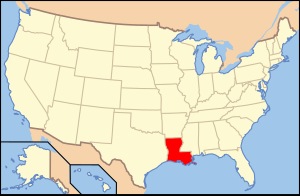
Paleontology in Louisiana refers to paleontological research occurring within or conducted by people from the U.S. state of Louisiana. Outcrops of fossil-bearing sediments and sedimentary rocks within Louisiana are quite rare. In part, this is because Louisiana’s semi-humid climate results in the rapid weathering and erosion of any exposures and the growth of thick vegetation that conceal any fossil-bearing strata. In addition, Holocene alluvial sediments left behind by rivers like the Mississippi, Red, and Ouachita, as well as marsh deposits, cover about 55% of Louisiana and deeply bury local fossiliferous strata.[1]
Nevertheless, paleontologists and geologists have succeeded in reconstructing much of the state's prehistory. Around the beginning of the Cambrian, Louisiana was part of a landmass called Rodinia. This supercontinent began to break up into the northern Laurentia and southern Gondwana. This division split off local rock which would become part of the southern supercontinent. The Iapetus Ocean filled the region between these landmasses, submerging Louisiana. While fossils of this age have been found within the region encompassed by the state's modern borders, they originated elsewhere and were incorporated as clasts in much younger rock and are therefore not informative about the wildlife of Paleozoic Louisiana.[1]
Louisiana remained completely underwater until the mid-Mississippian, when continental drift began to slowly reunite the northern and southern landmasses into Pangaea. Pangaea itself began to break up early in the Mesozoic, separating North America from the other continents and forming the Gulf of Mexico. Louisiana's fossil record begins in the Late Cretaceous Epoch and documents the presence of sharks and marine invertebrates. After the Cretaceous ended and the Age of Mammals began Louisiana would see local sea levels rise and fall. During submersions Louisiana was home to a diverse marine invertebrate fauna and the early whale Basilosaurus. Fragments of leaves and petrified wood documented the contemporary local flora. Later in the Cenozoic, Louisiana became a coastal plain wildlife inhabited by mammals like camels and Pleistocene megafauna like mastodons.[1]
Local Native Americans were the first humans to try to make sense of Louisiana's fossils. For instance, they interpreted mastodon remains as belonging to an ancient monster called the grandfather of the buffalo. Such remains and the Natives' mythological interpretations had already caught the attention of scientists like Georges Cuvier by the mid-1700s, which highlights Louisiana's long history of paleontology.[2] The state's most famous fossil site is exposed on the east bank of the Red River of the South at Montgomery Landing.[3]
- ^ a b c Cite error: The named reference
ipeditors-triowas invoked but never defined (see the help page). - ^ Cite error: The named reference
mayor-cuvier-62was invoked but never defined (see the help page). - ^ Cite error: The named reference
50states-louisiana-153was invoked but never defined (see the help page).